
|
|||
|---|---|---|---|
|
|
Integrated training vs traditional training in senior taekwondo practitioners Entrenamiento integrado versus entrenamiento tradicional en practicantes senior de taekwondo |
|
|
|
Universidad de las Fuerzas Armadas, ESPE (Ecuador) |
Mónica Gabriela Paucar Tipán Hipólito Vinicio Pisuña Quichimbla Dr.C. Santiago Calero Morales MSc. Excehomo Gabriel Coral Apolo MSc. Eduardo Marcelo Loachamin Aldaz MSc. Milton Patricio Rodríguez Rojas |
|
|
|
Abstract
Resumen
|
|||
|
|
Lecturas: Educación Física y Deportes, Revista Digital. Buenos Aires, Año 21, Nº 224, Enero de 2017. http://www.efdeportes.com/ |
|
|
1 / 1
Introduction
Sport training depends on many interrelated variables, while the modeling of such variables is a component managed as part of its process; the results are the consequences of an efficient planning of the sport training (Haff, & Nimphius, 2012; Maryan, Yuriy, & Olha, 2013; Bompa, & Buzzichelli, 2015). Combat sports require a design of a specific training plan, and this plan requires a characterization of the variables that have significant incidence on them (Fong, & Tsang, 2012; Attili, 2013; Guerra, 2014; Seo, Jung, Song, & Kim, 2015). Combat sports need a constant analysis of the training methodologies, which allows characterizing a high volume of technical elements, for which is necessary to have the required guidelines and conditions to do the training (Copello, 2013).
According to the Visotzky classification quoted by Gonzalez (2013) in the 10th Argentinean Congress and the 5th Latin American Congress of Physical Education and Sciences, the current training of combat sports include taekwondo as a hitting combat sport, since legs and arms are used in the competition to make impact, in a combat time of 1-3 minutes, with 1 minute break among rounds.
The characteristics of the combat sports include a high level of uncertainty and divided skills (Miarka, Branco, Vecchio, Camey, & Franchini, 2015; Parnabas, Parnabas, & Parnabas, 2015), since the athlete does not know how the opponent will act. Physiologically, the efforts made during combat can be anaerobic, alactic and lactic according to the duration of the execution of the techniques, and of resistance for the duration of the combat. Another feature is the balanced usage of body segments, a great explosiveness both in offensive and defensive actions and in various manifestations of resistance (Guerra, 2014), characteristics that along with others, should be correctly modeled through the training schedule.
The current training trends use integrated methods in several sports, assessing the effect of different trainings, both in practice and at laboratory level (Reed, Ford, Myer, & Hewett, 2012), given the need of integrating the training routines according to diverse sport training principles, as it is affirmed by Bompa, & Buzzichelli (2015).
Some theoreticians and scientists of the sport training, as well as some internationally renowned coaches, recognize the integration of contents in sport training as a vital aspect to achieve better trainings (Guiraud, Nigam, Gremeaux, Meyer, Juneau, & Bosquet, 2012; Litvinenko, 2013; Calero, 2014a,b; Fister, Rauter, Yang, & Ljubič, 2015). Some of the most successful models in team sports that integrate contents in the training are commonly known in some milieus as trainings similar to the game (Montenegro, 2010), which regularly develop a technical-tactical and physical-technical-tactical training of relevance, hence the importance of the study of these variables (Casolino, Lupo, Cortis, Chiodo, Minganti, Capranica, & Tessitore, 2012; Estevan, Álvarez, Falcó, & Castillo, 2014; Tornello, Capranica, Minganti, Chiodo, Condello, & Tessitore, 2014).
Integrated training is the integrated-physical-technical-tactical perception aimed at improving the development of the skills in the context of the competition (Antón, 1990; Calero, 2014a,b). Therefore, the integrated methodologies used when modeling the sport training are based on the sport practice, since the more resemblance of the modeled reality with the sport training content, the more probabilities of organic bio-adaptation to the physical and psychological effort, accomplishing the main principles of the improved trainings in a better way. These principles include specialization, specificity and individuality. The technical-tactical skills of the athlete and their physical and psychological skills are expressed as a whole and interrelated, since each one of them represents the support of the other (Robles, 2003). To Heredia, Ramon & Chulvi (2006) such skills are the basis of the multiplanar movements, which imply joint acceleration, stabilization and strength with the aim to improve the skill of the move, of the force of the mid zone and the neuromuscular efficiency.
In a competition, combat sports integrate all the performance factors; these factors have been object of work and research as isolated items inside the theory of the traditional training, according to Tschiene (1996).
When it comes to integrated training, there is emphasis on those methodologies that combine elements that have influence in a better sport performance (Robles, 2003). The search for a good performance in the sport activity encompasses things as a whole, and as such it must be understood. The new training trends assume this reality (Calero, 2013), and guide it towards a higher interconnection as it is the case of integrated training, in which technical, tactical and physical preparation work as a unit, for example, the technical training can be used as a means to develop psycho-tactic and physical skills (Ossorio, 2001).
In a competition, García, & Luque (2011) stress the importance of developing an integrated training model for combat sports, unifying each of the components of the guidelines of the athlete’s training so as to reach the utmost potential in the competition.
If the aim is to reach the utmost performance, it is necessary to master the technique, the tactic and the theory of the sport; the physical skills of an athlete favor both the acquisition of the technique and the correct execution of the moves (Ossorio, 2001). So the practitioner bases his success in diverse groups of skills, from both the physical and the tactical and psychological point of view, which are reinforced with the contributions of the theoretical formation (Conde & Delgado, 2000).
Peñalver (2012) in the paper Tratamiento metodológico a la preparación mixta con esgrimistas de Camagüey (Methodological treatment to mixed training with fencers of Camaguey province) states that in combat, the body should adapt to different physical loads, for which the recommendation is to do mixed trainings focused on improving the physical capacity, the technique, the tactic and the strategy, along with the psychic functions, that’s why a correct implementation of the principles of the sport training is indispensable.
The training of the physical components of a combat sport should be aimed at improving the competitive state on the tatami and increasing their general sport level (García, & Luque, 2011). Combat sports like taekwondo require power, strength in the hits, flexibility for an efficient technique, and an aerobic resistance base to resist the training loads, which will be applied during the training sessions.
The methodology of the integrated physical training requires a stable and automatic model of the athlete, reason for which skills that complement each other should be integrated so that one develops the other. By considering the aforementioned, the definition of an integrated training model allows having an adequate fitness adapted to the reality modeled, implying an optimal state for the competition. In Ecuadorian taekwondo, the guidelines for the athlete’s training are regularly work in isolation, applying a traditional training method that, according to the authors, does not allow a successful competitive state.
In taekwondo, the use of all the parts of the body is indispensable in terms of coordination; however, in the current planning, the training model applied on athletes of the ESPE Club tends to give an isolated approach to technical moves and trained body segments, which do not include all the main parts of the body equitably for a correct technical-tactical execution; therefore, the performance of the athletes in a competition is not successful, since the traditional training does not allow to perform, among other things, a training based on a vision taking into account the characteristics of the rival, as it is affirmed by Calero (2014a,b).
Although from the theoretical point of view several authors show the benefits of an integrated training, it is necessary to scientifically prove whether this training can improve the sport preparation in senior taekwondo more than a traditional training method. Therefore, the goal of this paper is to apply an integrated training program aimed at improving the combat performance of senior taekwondo practitioners of the ESPE Club, and at the same time demonstrate that this kind of training is better than the traditional training applied at present.
Material and methods
The experimental sample is made up by 12 male and female athletes of the ESPE taekwondo club, senior category, who were undergone to an integrated training program in year 2016, and the comparison sample is made up by 12 male and female athletes of the ESPE taekwondo club, senior category, who were part of the traditional training program in 2015. Both groups with an average age of 19-28 years old.
Instruments
The following physical and technical-tactical tests were applied:
-
Kick test: Bandal chagi, Dollyo chagi, Nerioy chagi in 6 seconds
-
Explosive force test: Jump test, Long test.
-
Force-resistance test: elbow flexion test on the floor in 30 seconds, abdominals in 30 seconds.
-
Flexibility Test: Frontsplit, and side split.
On the other hand was applied the Wilcoxon signed rank test and the Mann-Whitney U test (p≤0,05).
Methodology
The traditional model or training program was basically structured as follows:
|
Guidelines |
Indicators |
Training Direction |
|
Resistance-force Lower limbs |
Repetitions |
Physical |
|
Explosive Force Lower limbs (one move) |
Repetitions |
Physical-Technical |
|
General exercises |
Repetitions |
Physical |
|
Kicks |
Repetitions |
Technical |
The integrated model or training program was basically structured as follows:
|
Guidelines |
Indicators |
Training Direction |
|
Resistance- Force - Lower limbs - Upper limbs |
Repetitions per units of time and intensity depending on the F.C |
Physical-Technical |
|
Explosive Force - Lower limbs - Upper limbs |
Technical repetitions per seconds with self load. Time (seconds) |
Physical-Technical |
|
Develop stability in the central area, CORE |
Repetitions and time (seconds) |
Physical-Theoretical |
|
General implementation through integrated exercises |
Technical repetitions per units of time and series |
Physical-Technical |
|
Improvement of the tactical thinking - Offensive and defensive system |
Effectiveness of the technique and tactic with competition time frequency |
Technical-Tactical Psychological-Theoretical |
Results and discussion
Table 1. Assessment tests of the applied technical performance. Experimental group (Integrated Training)
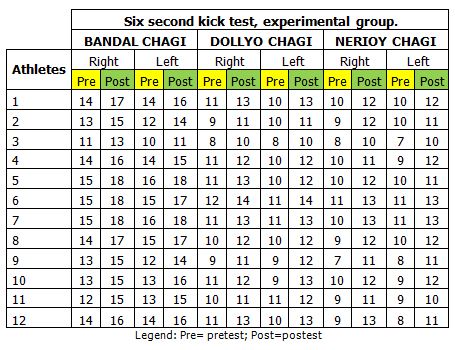
Table 2. Assessment tests of the applied physical performance. Experimental group (Integrated training)
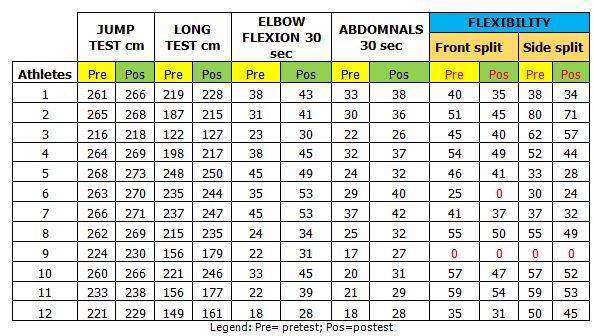
Table 3. Applied physical performance post-test results to the control group. Traditional training
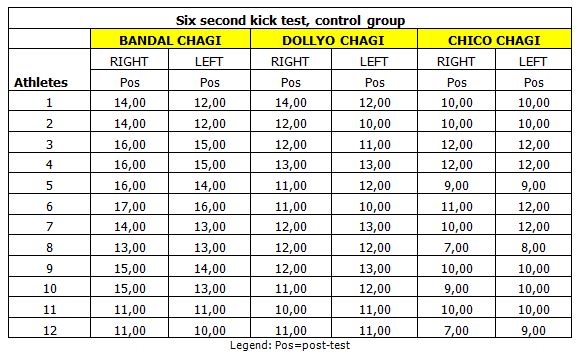
By comparing the data of the pre-test and the post-test (E.G) for the experimental group (integrated training), according to the Wilcoxon signed rank test was determined the following:
Table 4. Comparison between the pre-test and the post-test in the six second kick test (Bandal Chagi; right) in athletes undergone to integrated training. Wilcoxon signed rank test
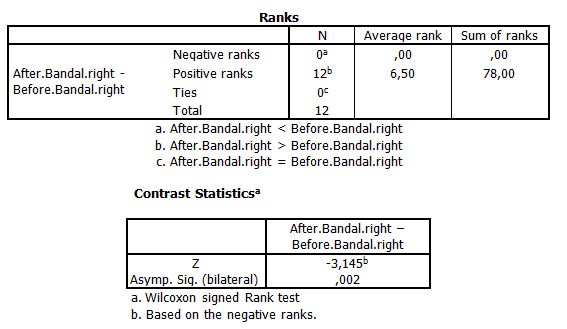
The Wilcoxon signed rank test determined the existence of significant differences (p=0,002) between the pre-test and the post-test of the six second kick test (Bandal Chagi; right) for the athletes undergone to the integrated training.
Table 5. Comparison between the pre-test and the post-test of the six second kick test (Bandal Chagi; left) in the athletes undergone to the integrated training. Wilcoxon signed rank test
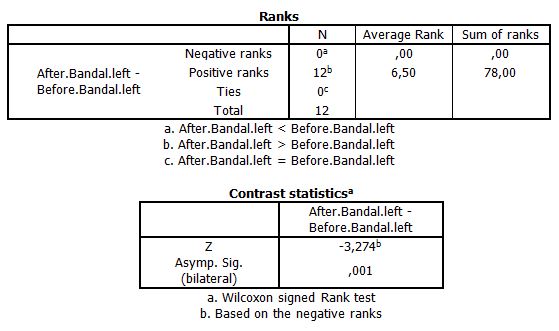
The Wilcoxon signed rank test determined significant differences (p=0,001) between the pre-test and the post-test of the six second kick test (Bandal Chagi; left) for the athletes undergone to the integrated training.
Table 6. Comparison between the pre-test and the post-test of the six second kick test (Dollyo chagi; right) in athletes undergone to integrated training. Wilcoxon signed rank test
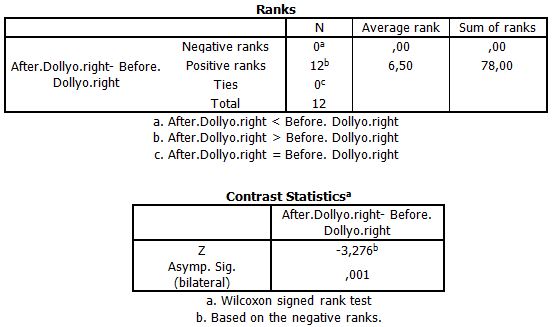
The Wilcoxon signed rank test determined significant differences (p=0,001) between the pre-test and the post-test of the six second kick test (Dollyo Chagi; right) for the athletes undergone to integrated training model.
Table 7. Comparison between the pre-test and the post-test of the six second kick test (Dollyo Chagi; left) in the athletes undergone to the integrated training program. Wilcoxon signed rank test

The Wilcoxon signed rank test determined significant differences (p=0,002) between the pre-test and the post-test of the six second kick test (Dollyo Chagi; left) for the athletes undergone to integrated training model.
Table 8. Comparison between the pre-test and the post-test of the six second kick test (Neryo Chagi; right) in the athletes undergone to the integrated training program. Wilcoxon signed rank test
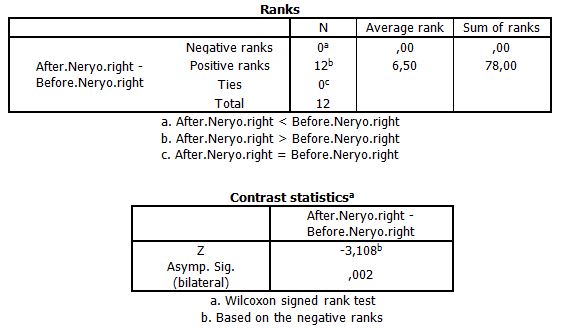
The Wilcoxon signed rank test determined significant differences (p=0,002) between the pre-test and the post-test of the six second kick test (Neryo Chagi; right) for the athletes undergone to integrated training model.
Table 9. Comparison between the pre-test and the post-test of the six second kick test (Neryo Chagi; left) in the athletes undergone to the integrated training program. Wilcoxon signed rank test

The Wilcoxon signed rank test determined significant differences (p=0,002) between the pre-test and the post-test of the six second kick test (Neryo Chagi; left) for the athletes undergone to integrated training model.
Table 10. Comparison between the pre-test and the post-test of the Explosive force test (Jump test) in the athletes undergone to the integrated training program. Wilcoxon signed rank test
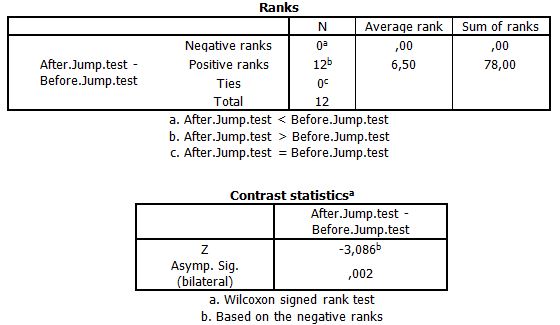
The Wilcoxon signed rank test determined significant differences (p=0,002) between the pre-test and the post-test of the Explosive force test (Jump.test) for the athletes undergone to integrated training model.
Table 11. Comparison between the pre-test and the post-test of the Explosive force test (Long test) in the athletes undergone to the integrated training program. Wilcoxon signed rank test

The Wilcoxon signed rank test determined significant differences (p=0,002) between the pre-test and the post-test of the Explosive force test (Long.test) for the athletes undergone to integrated training model.
Table 12. Comparison between the pre-test and the post-test of the Force-Resistance test (elbow flexion) in the athletes undergone to the integrated training program. Wilcoxon signed rank test

The Wilcoxon signed rank test determined significant differences (p=0,002) between the pre-test and the post-test of the Force-Resistance test (Elbow flexion) for the athletes undergone to integrated training model.
Table 13. Comparison between the pre-test and the post-test of the Force-Resistance test in 30 seconds (Abdominals) in the athletes undergone to the integrated training program. Wilcoxon signed rank test
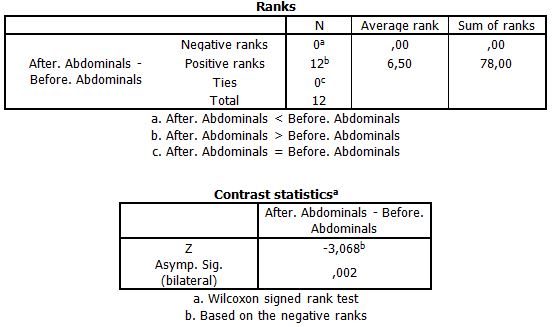
The Wilcoxon signed rank test determined significant differences (p=0,002) between the pre-test and the post-test of the Force-Resistance test in 30 seconds (Abdominals) for the athletes undergone to integrated training model.
Table 14. Comparison between the pre-test and the post-test of the Flexibility test (Front split) in the athletes undergone to the integrated training program. Wilcoxon signed rank test

The Wilcoxon signed rank test determined significant differences (p=0,003) between the pre-test and the post-test of the Flexibility test (Front split) for the athletes undergone to integrated training model, taking into account that the negative ranks represent the increase of the athletes’ flexibility.
Table 15. Comparison between the pre-test and the post-test of the Flexibility test in centimeters (Side split) in the athletes undergone to the integrated training program. Wilcoxon signed rank test
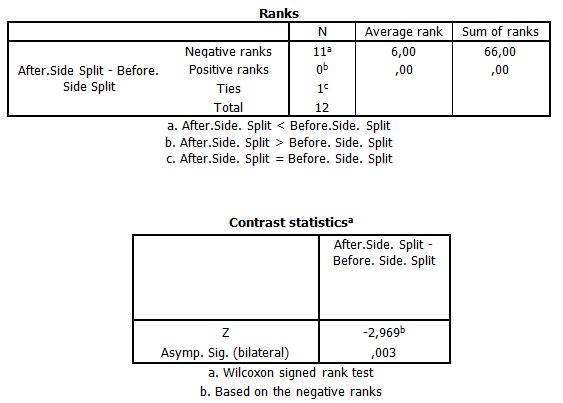
The Wilcoxon signed rank test determined significant differences (p=0,003) between the pre-test and the post-test of the Flexibility test (Side split) for the athletes undergone to integrated training model, taking into account that the negative ranks represent the increase of the athletes’ flexibility.
The integrated training model showed significant improvements in all the physical and technical-tactical tests, taking into account, as Copello (2013) affirms, the diverse methodological guidelines and conditions of the training, and in the case of the integrated program it was made a design of the content with a physical-technical-tactical approach (Antón, 1990; Casolino, Lupo, Cortis, Chiodo, Minganti, Capranica, & Tessitore, 2012; Estevan, Álvarez, Falcó, & Castillo, 2014; Tornello, Capranica, Minganti, Chiodo, Condello, & Tessitore, 2014; Calero, 2014a,b), since the technical-tactical skills of the athletes and their physical and psychological qualities are expressed in a close relationship (Robles, 2003).
Given the fact that the traditional training program also showed significant improvements in the aforementioned tests, we set a comparison between independent samples to assess if between the control and the experimental groups are equally significant differences in terms of performance, which allows defining which training (integrated or traditional) improves best the sport preparation of the senior taekwondo practitioners undergone to the study.
Table 16. Comparison between the experimental group (Group 1: integrated training) and the control group (Group 2: Traditional training) in the six second kick test (Bandal Chagi; right). Mann-Whitney U test
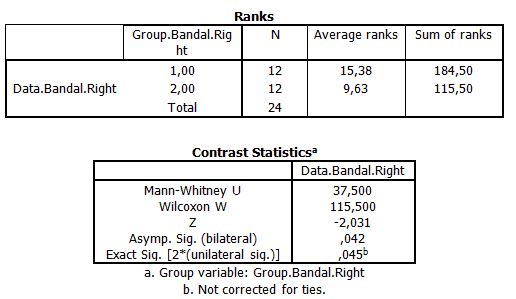
The Mann-Whitney U test shows the existence of significant differences (p¨=0,042) by comparing the data of the six second kick test (Bandal Chagi; right) of the athletes undergone to the integrated training (Group 1) and those undergone to the traditional training program (Group 2). Given the average ranks obtained, it was demonstrated that the best average rank belongs to the integrated training group (15,38) over the traditional training (9,63), inferring that the training program has a better impact on the Right Bandal Chagi.
Table 17. Comparison between the experimental group (Group 1: integrated training) and the control group (Group 2: Traditional training) in the six second kick test (Bandal Chagi; left). Mann-Whitney U test
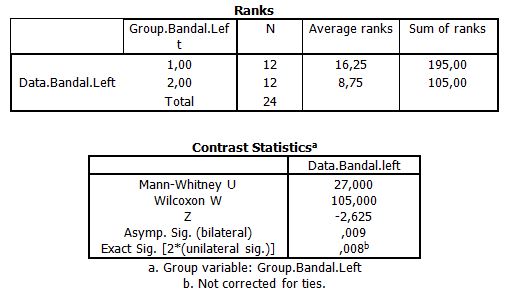
The Mann-Whitney U test shows the existence of significant differences (p¨=0,009) by comparing the data of the six second kick test (Bandal Chagi; left) of the athletes undergone to the integrated training (Group 1) and those undergone to the traditional training program (Group 2). Given the average ranks obtained, it was demonstrated that the best average rank belongs to the integrated training group (16,25) over the traditional training (8,75), inferring that the training program has a better impact on the Left Bandal Chagi.
Table 18. Comparison between the experimental group (Group 1: integrated training) and the control group (Group 2: Traditional training) in the six second kick test (Dollyo Chagi; right). Mann-Whitney U test
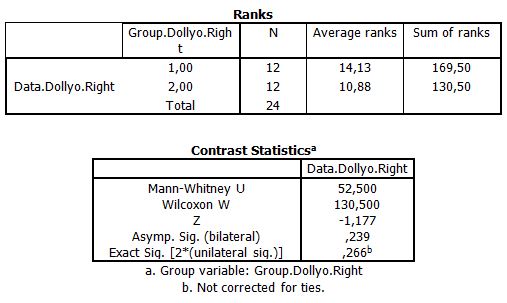
The Mann-Whitney U test shows the non-existence of significant differences (p¨=0,239) by comparing the data of the six second kick test (Dollyo Chagi; right) of the athletes undergone to the integrated training (Group 1) and those undergone to the traditional training program (Group 2). However, given the average ranks obtained, it was demonstrated that the best average rank belongs to the integrated training group (14,13) over the traditional training (10,88), inferring that the training program slightly improves the Right Dollyo Chagi.
Table 19. Comparison between the experimental group (Group 1: integrated training) and the control group (Group 2: Traditional training) in the six second kick test (Dollyo Chagi; left). Mann-Whitney U test
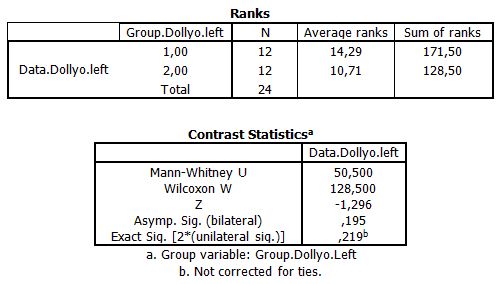
The Mann-Whitney U test shows the non-existence of significant differences (p¨=0,195) by comparing the data of the six second kick test (Dollyo Chagi; right) of the athletes undergone to the integrated training (Group 1) and those undergone to the traditional training program (Group 2). However, given the average ranks obtained, it was demonstrated that the best average rank belongs to the integrated training group (14,29) over the traditional training (10,71), inferring that the training program slightly improves the Left Dollyo Chagi.
Table 20. Comparison between the experimental group (Group 1: integrated training) and the control group (Group 2: Traditional training) in the Force- resistance test (Elbow flexions) in 30 seconds. Mann-Whitney U test
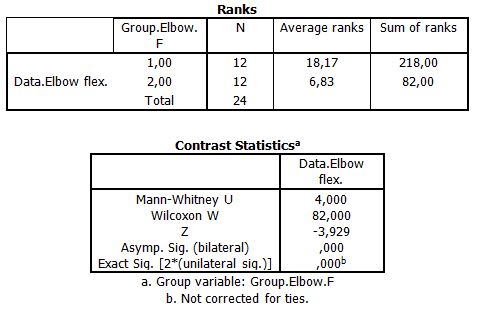
The Mann-Whitney U test shows the existence of significant differences (p¨=0,000) by comparing the data of the Elbow flexion test of the athletes undergone to the integrated training (Group 1) and those undergone to the traditional training program (Group 2). Given the average ranks obtained, it was demonstrated that the best average rank belongs to the integrated training group (18,17) over the traditional training (6,83), inferring that the training program significantly improves the Elbow flexions.
Table 21. Comparison between the experimental group (Group 1: integrated training) and the control group (Group 2: Traditional training) in the Force- resistance test (Abdominals) in 30 seconds. Mann-Whitney U test
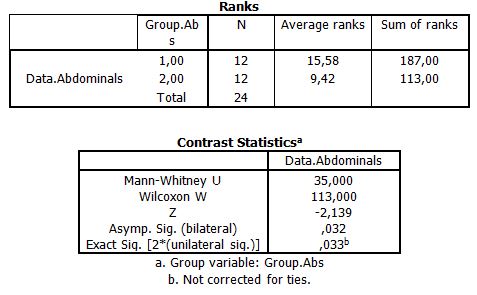
The Mann-Whitney U test shows the existence of significant differences (p¨=0,032) by comparing the data of the Abdominals test of the athletes undergone to the integrated training (Group 1) and those undergone to the traditional training program (Group 2). Given the average ranks obtained, it was demonstrated that the best average rank belongs to the integrated training group (15,58) over the traditional training (9,42), inferring that the training program significantly improves the abdominal performance.
The authors of the present paper consider that the statements exposed by several sport training theoreticians and technical directors, such as Guiraud, Nigam, Gremeaux, Meyer, Juneau, & Bosquet (2012); Litvinenko (2013) and Fister, Rauter, Yang, & Ljubič (2015), among others, about the integration of several contents of the sport training to attain improvements is vital to achieve high level performances in a short period of time, for which the integrated training strategy will make possible to reach better sport performances.
Conclusions
Traditional training, which is used by different sport training entities in a more isolated way, should be modified or replaced by a much more integrated training that gathers various components in the content of the preparation of the athlete, in order to improve the training performance and therefore the competitive level of senior taekwondo practitioners, as it is demonstrated in the present research paper.
Acknowledgements
To there search project: Gestión de competencias para publicaciones científicas en estudiantes de pregrado y postgrado de la Universidad de las Fuerzas Armadas ESPE.
Bibliography
-
Antón, J. (1990). Balonmano. Fundamentos y etapas de aprendizaje. Madrid: Gymnos.
-
Attili, D. G. (2013). Planificación del entrenamiento en el Taekwondo Olímpico. In X Congreso Argentino y V Latinoamericano de Educación Física y Ciencias (La Plata).
-
Bompa, T., & Buzzichelli, C. (2015). Periodization Training for Sports, 3E. Champaign, Il: Human Kinetics.
-
Calero, S. (2013). Nuevas tendencias mundiales en el proceso de dirección del entrenamiento deportivo. Curso de Postgrado impartido en la Universidad de Guayaquil. Instituto de Investigaciones, Ecuador.
-
Calero, S. (2014a). Fundamentos del entrenamiento deportivo optimizado. Curso impartido en la Facultad de Educación Física, Deportes y Recreación de la Universidad de Guayaquil. Ecuador.
-
Calero, S. (2014b). Fundamentos del entrenamiento optimizado. Cómo lograr un alto rendimiento deportivo en el menor tiempo posible. Primer Congreso de Fisioterapia y Deporte. Universidad del Valle de México; Villahermosa, Tabasco, Estados Unidos Mexicanos.
-
Casolino, E., Lupo, C., Cortis, C., Chiodo, S., Minganti, C., Capranica, L., & Tessitore, A. (2012). Technical and tactical analysis of youth taekwondo performance. The Journal of Strength & Conditioning Research, 26(6), 1489-1495.
-
Conde, J., & Delgado, M. (2000). Características del proceso de entrenamiento. En D. Cárdenas (Coord.). El entrenamiento integrado de las habilidades visuales en la iniciación deportiva. Málaga: Ediciones Aljibe.
-
Copello, M., Alverdi, D., & Fuentes, N. (2013). Sistema de orientaciones metodológicas para los deportes de combate en la categoría 13-14 años. Lecturas: Educación Física y Deportes. Buenos Aires - Año 18 - Nº 181 - Junio. http://www.efdeportes.com/efd181/orientaciones-para-los-deportes-de-combate.htm
-
Estevan, I., Álvarez, O., Falcó, C., & Castillo, I. (2014). Self-efficacy and performance of the roundhouse kick in taekwondo. Revista de Artes Marciales Asiáticas, 9(2), 97-105.
-
Fister, I., Rauter, S., Yang, X. S., & Ljubič, K. (2015). Planning the sports training sessions with the bat algorithm. Neurocomputing, 149, 993-1002
-
Fong, S. S., & Tsang, W. W. (2012). Relationship between the duration of taekwondo training and lower limb muscle strength in adolescents. Hong Kong Physiotherapy Journal, 30(1), 25-28.
-
García, R. H., & Luque, G. T. (2011). Preparación física integrada en deportes de combate. E-balonmano.com: revista de Ciencias del Deporte, 7, 31-38.
-
González Borda, J. I. (2013). Entrenamiento de los Deportes de Combate en la actualidad. In X Congreso Argentino y V Latinoamericano de Educación Física y Ciencias (La Plata, 2013).
-
Guerra, E.R. (2014). Recomendaciones para el desarrollo de las capacidades físicas de los deportistas de combate. Lecturas: Educación Física y Deportes. Buenos Aires, Año 19, Nº 199, Diciembre. http://www.efdeportes.com/efd199/capacidades-fisicas-de-los-deportistas-de-combate.htm
-
Guiraud, T., Nigam, A., Gremeaux, V., Meyer, P., Juneau, M., & Bosquet, L. (2012). High-intensity interval training in cardiac rehabilitation. Sports Medicine, 42(7), 587-605.
-
Haff, G. G., & Nimphius, S. (2012). Training principles for power. Strength & Conditioning Journal, 34(6), 2-12.
-
Heredia, Ramón, & Chulvi (2006). Entrenamiento funcional: revisión y replanteamientos. Lecturas: Educación Física y Deportes. Buenos Aires - Año 11 - N° 98 - Julio. http://www.efdeportes.com/efd98/efunc.htm
-
Litvinenko, A. M. (2013). Efficiency of application of means of sports preparation of combat sportsmen in physical training of students of technical high school. Fiziceskoe vospitanie studentov, 2.
-
Maryan, P., Yuriy, B., & Olha, Z. (2013). Features of theoretical training in combative sports. Journal of Physical Education and Sport, 13(2), 195.
-
Miarka, B., Branco, B. H., Vecchio, F. B., Camey, S., & Franchini, E. (2015). Development and validation of a time-motion judo combat model based on the Markovian Processes. International Journal of Performance Analysis in Sport, 15(1), 315-331.
-
Montenegro, M. (2010). El entrenamiento similar al juego. Consultado el 11 de Octubre del 2016 de la Web: http://profmaximontenegro.blogspot.com/2010/07/el-entrenamiento-similar-al-juego.html
-
Ossorio, D. (2001). La influencia motivadora del entrenamiento integrado sobre la percepción del esfuerzo en el e entrenamiento aeróbico. Lecturas: Educación Física y Deportes. Buenos Aires - Año 7 - N° 41 - Octubre. http://www.efdeportes.com/efd41/infl.htm
-
Parnabas, V., Parnabas, J., & Parnabas, A. M. (2015). The Influence of Cognitive Anxiety on Sport Performance among Taekwondo Athletes. The international Journal of Indian Psychology. Volume 2, Special Issue
-
Peñalver, M.V. (2012). Tratamiento metodológico a la preparación mixta con esgrimistas de Camagüey: una propuesta. Lecturas: Educación Física y Deportes. Buenos Aires - Año 17 - Nº 168 - Mayo. http://www.efdeportes.com/efd168/la-preparacion-mixta-con-esgrimistas.htm
-
Reed, C. A., Ford, K. R., Myer, G. D., & Hewett, T. E. (2012). The effects of isolated and integrated ‘core stability’training on athletic performance measures. Sports medicine, 42(8), 697-706.
-
Robles, J. (2003). La enseñanza del judo mediante una metodología activa. Una propuesta de entrenamiento integrado. Lecturas: Educación Física y Deportes. Buenos Aires - Año 9 - N° 64 - Septiembre. http://www.efdeportes.com/efd64/judo.htm
-
Seo, M. W., Jung, H. C., Song, J. K., & Kim, H. B. (2015). Effect of 8 weeks of pre-season training on body composition, physical fitness, anaerobic capacity, and isokinetic muscle strength in male and female collegiate taekwondo athletes. Journal of exercise rehabilitation, 11(2), 101.
-
Tornello, F., Capranica, L., Minganti, C., Chiodo, S., Condello, G., & Tessitore, A. (2014). Technical-tactical analysis of youth Olympic Taekwondo combat. The Journal of Strength & Conditioning Research, 28(4), 1151-1157.
-
Tschiene, P. (1996). Influencia de la carga de condición física sobre la perfección de técnica y táctica. I.A.D. Málaga.
Another articles in English

|
|
|---|---|
|
EFDeportes.com, Revista
Digital · Año 21 · N° 224 | Buenos Aires,
Enero de 2017 |
|